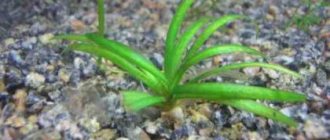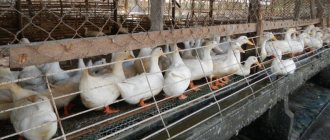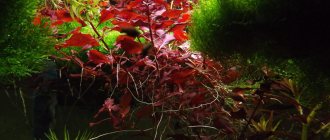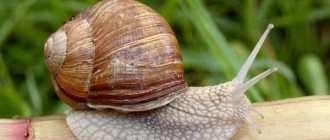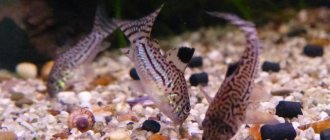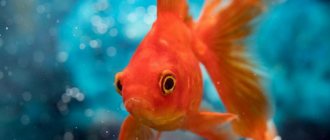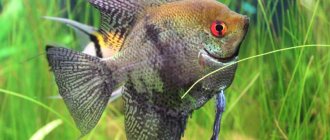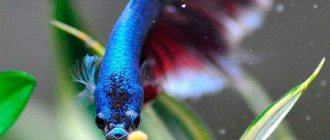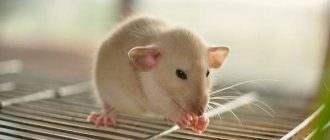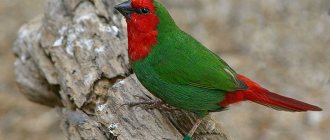4.8
(17)
When choosing vegetation for an aquarium, you want it to grow actively, be beautiful and not require special care. There is a lot of similar flora, which grows incredibly strongly in natural conditions and at the same time feels good in artificial conditions. One of these is bacopa.
Description
This is a perennial plant that has a fairly wide habitat. It is found in water bodies of India, Africa and America. Prefers marshy areas or flooded banks. There are varieties that even germinate on land, but they are called “sutera”.
Bacopa thrives in tropical and subtropical climates. In total, today there are over 100 species of this plant, most of which are an aquatic subspecies.
The plant has a long stem along which oval green leaves grow. They reach only 2.5 cm in length. If there is a lot of nutrients in the soil and a powerful lamp is installed in the aquarium, then the bushes will grow quickly. In general, the size directly depends on the variety and conditions in which the flora lives.
Price
Depending on the variety, Carolina bacopa costs from 40 to 230 rubles per sprig. The plant with green leaves is the cheapest. Cultivated shrubs with purple flowers will cost the buyer more than 200 rubles.
Bacopa Carolinas is an unpretentious plant. It not only decorates the tank, but also benefits the aquarium inhabitants. The variety of varieties allows you to choose a flower that matches your design solution. And their ease of care makes it possible to use them for cultivation not only by experienced aquarists, but also by novice hobbyists.
If you liked the article, leave comments and share a link to it on social networks.
Content
One of the main advantages of bacopa is that it is very unpretentious. It can be successfully kept in both a regular warm and tropical aquarium. But it is best to grow it in a greenhouse or paludarium, since in nature this underwater flora is found in swampy areas.
In general, the conditions of detention are as follows:
Water parameters. The temperature should be about 22-28 degrees. If it is less, then growth stops and the bush may die. As for the other parameters, they are no less important. Bacopa likes water with a low dH and a slightly acidic reaction. With great rigidity, the leaves become deformed. Therefore dH should be no more than 8 degrees. It is necessary to do water changes twice a month, 20-25% of the total volume;
Soil . The optimal substrate is small pebbles or sand. The layer can be small, about 4 cm, since the root system of the plants is weak. They feed primarily through water rather than soil. The substrate itself may be slightly silted, simulating a swamp;
Fertilizers . These will not be needed, since bacopa grows well under normal conditions. It only needs the nutrients that naturally form in water. Macro and microelements will not be needed;
Lighting . This is an important composition for this flora. The best option is natural sunlight. The lamp must work at least 11 hours a day. Intensity – from 0.5 W/l, or better yet more.
We recommend reading the article: Types of aquarium lamps, lighting spectrum and how to choose the right one?
The use of bacopa in aquascaping
Aquascaping is the creation of aquatic or underwater landscapes . It first appeared in Japan, a country where they pay great attention to the beauty of nature. Talented aqua designers create real works of art in an ordinary aquarium, using not only plants, but also stones, driftwood and other natural materials.
Carolina bacopa is a very popular plant among aquascapers. It is ideal for creating a beautiful landscape. Considering the height of the stem, it is better to place bacopa in the background, not forgetting that it loves light.
https://youtube.com/watch?v=Gf9dWZqkSrc
Quite often, bacopa is used for vertical gardening. In order for the stem to strive upward, it must be secured to the ground with a stone. Then the plant itself will grow in the right direction.
It is important to monitor the growth of bacopa. If it is regularly pruned in order to propagate, the stem will send out more and more new shoots, resulting in the formation of dense, unkempt thickets. The old plant must be pruned for further propagation, and the stem removed from the water. Young sprigs of Carolina bacopa look fresh and attractive.
Carolina bacopa grows very quickly, allowing you to create underwater gardens as envisioned by the designer in a short time. With the right combination of aquarium plants, you can achieve excellent results. https://youtube.com/watch?v=Z_-HWOM9Rik
Reproduction and planting
Bacopa propagates vegetatively, through stem cuttings. When the stem grows to 10-15 cm in length, it can be planted in the ground. If there are no roots yet, then you can leave the daughter bush in the water column. Once the root system is formed, it can be planted.
Planting and care are not particularly difficult. It is best to keep your bacopa in a separate pot and place it on a shelf next to a natural light source or a good lamp. In an aquarium, bushes look attractive when placed in the corners. Soon they will grow and occupy the entire side of the aquarium.
If you want to create a beautiful and green carpet, then bacopa can be pressed down with a stone. After a while, it will begin to take root and establish itself in this position, growing horizontally.
Lighting
Lighting is preferably bright. In deep aquariums, bacopa feels bad primarily due to lack of light. If the depth of the aquarium is more than 30 cm, it is better to place it in a separate bowl on a side shelf, raised closer to the lights, or create side lighting. Natural, and especially diffused sunlight, is very beneficial for the plant. The power of the lamps is selected individually. Artificial and natural light can be combined in any way. The length of daylight is desirable at least 12 hours.
Kinds
As already mentioned, there are many types of bacopa, but the following varieties of this tropical plant are especially common among aquarists.
Caroline
Perhaps one of the most popular types. Its homeland is Latin America. The oval leaves grow up to 2 cm. The plant prefers soft water; in hard water its appearance deteriorates significantly. You can trim it to create interesting compositions.
Australian
Already from the name it is clear where this plant is found in nature. The leaves grow no more than 1.5 cm. They have wavy outlines. Planted in the back and middle part of the aquarium. No special conditions are needed for growing, but the supply of CO2 will make the bushes more lush and rich. It needs to be trimmed periodically.
Madagascar
Found on the shores of the island of the same name. Differs in large sizes. The sheets are up to 4 cm thick and up to 3 cm long, but not more than 15 cm high. Therefore, it is planted in the middle or in front. Loves bright light. If there is insufficient light, the lower leaves die. An excellent option for a paludarium.
Zaltsman
Also a popular species that grows in waters ranging from Mexico to Paraguay. Visually, it is very similar to Carolina bacopa: straight stem, dense paired leaves. But the color can be very different, from the usual green to red or even purple. Therefore, sometimes aquarists pass off this species as another, without being guided by the characteristics of this vegetation.
Does not cause any particular difficulties in care. All you need is good soil and bright light. The more powerful the lamp, the richer the color of the leaves.
Colorata
In fact, this is a breeding form of Bacopa Carolinas. It was brought to the USA, and from there it spread throughout the world. Accordingly, it is impossible to find it in natural reservoirs. The appearance is the same, except for the color. Young plants have a purple or pink tint. But then the color, when they grow up, returns to normal green.
Pinnately
It differs from other varieties in that it requires special conditions of detention. In nature, it can be seen in Brazilian reservoirs. Lives both in water and on land. The stem is straight, on which there are paired leaves, divided into 5-7 parts. To prevent the bush from disappearing, you need soft and acidic water, bright light, a temperature of 25-27 degrees, and a nutrient substrate.
Japanese
It is interesting that this plant grows far from the country after which it was named. It is found in South America. However, in Japan it was introduced into the aquarium hobby, which is why it began to be called that.
Visually not very different from other species. It reaches a height of 20 cm. It grows quickly. You need bright light, soft and acidic water, and nutrient-rich soil.
Accommodation
Varieties of green underwater inhabitants have an individual appearance, therefore they are located in different places in an artificial reservoir:
- Monnieri will look best in the corners of the tank, as this variety, due to its rapid growth, will occupy the entire corner and create an interesting look.
- The pinnate flower requires attention and care, as it is fragile and painful to plant, so the variety is planted away from other types of flora.
- The Australian subspecies looks attractive in the foreground of a pond.
An interesting design is to plant several varieties of plants at once in different parts of the aquarium.
Benefits for the aquarium
Aquarists prefer bacopa due to a number of its benefits:
- Attractive appearance.
- Unpretentiousness.
- Good disease resistance.
- Fast growth.
- Performs the functions of a filter element.
But experienced aquarists choose bacopa for completely different reasons. The Carolina variety has decorative properties and is capable of destroying organic matter that accumulates in water. This ultimately prevents the development of harmful parasites and other pests. For example, a black beard, a Vietnamese woman. Leaf plates are often used to feed fish. Since they contain many vitamins and minerals.
Carolina bacopa is an aquarium plant that looks cute, attractive, does not require special care, grows quickly, and most importantly, quickly adapts to any conditions. For full growth of the plant, good lighting and clean water are enough.

